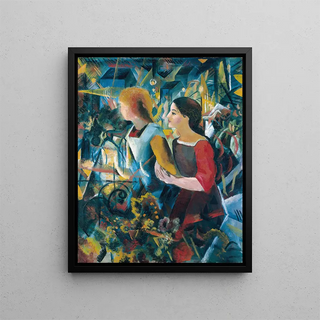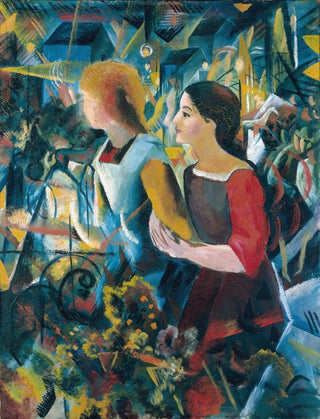Art print | Two Girls - August Macke


View from behind

Frame (optional)
The artwork "Two Girls" by August Macke is an iconic piece from the early 20th century, embodying both the exuberance of color and the lightness of subject. Created in 1910, this painting immerses us in a universe where joie de vivre and the carefree spirit of young girls intertwine. The female figures, delicate yet vibrant, seem to dance with the colors, offering a vision filled with freshness. Gazing upon this piece, one is immediately transported to a world where innocence and beauty meet, making this representation a true ode to youth and life.
Style and uniqueness of the artwork
Macke, a major figure of the Expressionist movement, stands out for his bold use of colors and his ability to capture the moment. In "Two Girls," vivid hues and simplified forms create an atmosphere that is both joyful and melancholic. The faces of the young girls, though stylized, express an emotional depth that transcends mere representation. Elements of nature in the background blend harmoniously into the composition, reinforcing the idea of an intimate connection between the characters and their environment. This painting is a tribute to the fleeting beauty of childhood, where each brushstroke seems to evoke a story, an emotion, a dream.
The artist and his influence
August Macke, born in 1887 in Meschede, is one of the pioneers of German Expressionism. His career, tragically cut short by World War I, left an indelible mark on modern art. Influenced by movements such as Fauvism and Cubism, Macke developed a unique style that combines abstraction and figuration. His travels in France and Tunisia also enriched his palette and artistic vision. In "Two Girls," this influence is evident through the use of pure colors and dynamic forms. The work reflects a sensitivity to the beauty of everyday life, while exploring themes of youth and nature. Macke's contribution to art history is invaluable, and his legacy

Matte finish

View from behind

Frame (optional)
The artwork "Two Girls" by August Macke is an iconic piece from the early 20th century, embodying both the exuberance of color and the lightness of subject. Created in 1910, this painting immerses us in a universe where joie de vivre and the carefree spirit of young girls intertwine. The female figures, delicate yet vibrant, seem to dance with the colors, offering a vision filled with freshness. Gazing upon this piece, one is immediately transported to a world where innocence and beauty meet, making this representation a true ode to youth and life.
Style and uniqueness of the artwork
Macke, a major figure of the Expressionist movement, stands out for his bold use of colors and his ability to capture the moment. In "Two Girls," vivid hues and simplified forms create an atmosphere that is both joyful and melancholic. The faces of the young girls, though stylized, express an emotional depth that transcends mere representation. Elements of nature in the background blend harmoniously into the composition, reinforcing the idea of an intimate connection between the characters and their environment. This painting is a tribute to the fleeting beauty of childhood, where each brushstroke seems to evoke a story, an emotion, a dream.
The artist and his influence
August Macke, born in 1887 in Meschede, is one of the pioneers of German Expressionism. His career, tragically cut short by World War I, left an indelible mark on modern art. Influenced by movements such as Fauvism and Cubism, Macke developed a unique style that combines abstraction and figuration. His travels in France and Tunisia also enriched his palette and artistic vision. In "Two Girls," this influence is evident through the use of pure colors and dynamic forms. The work reflects a sensitivity to the beauty of everyday life, while exploring themes of youth and nature. Macke's contribution to art history is invaluable, and his legacy






